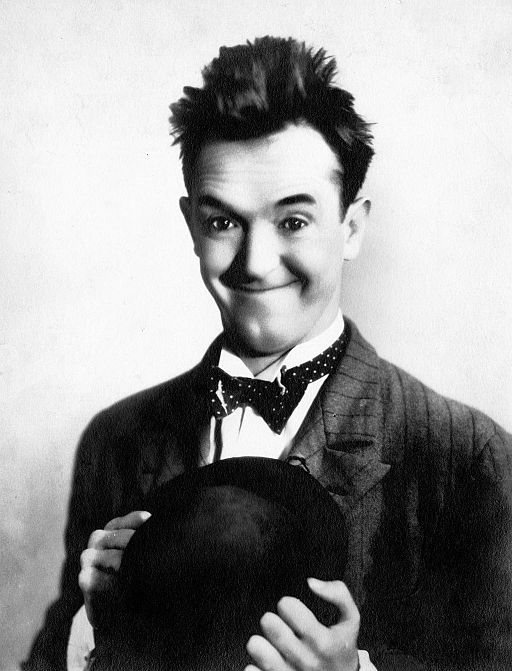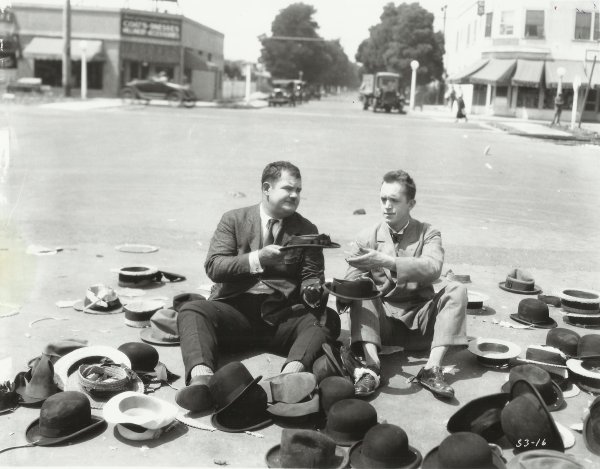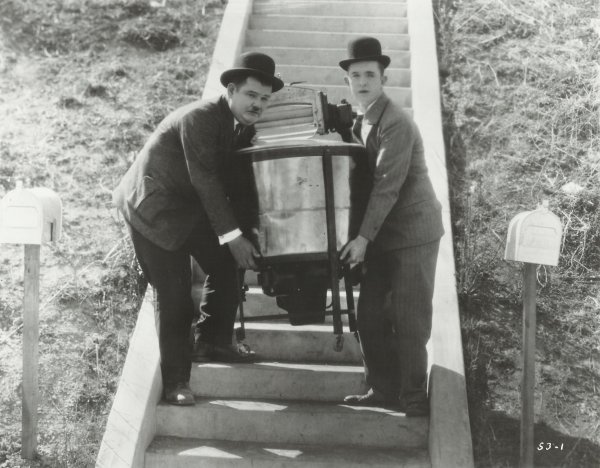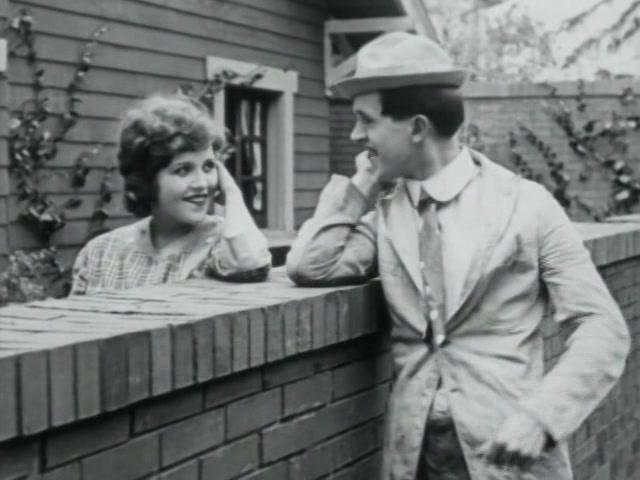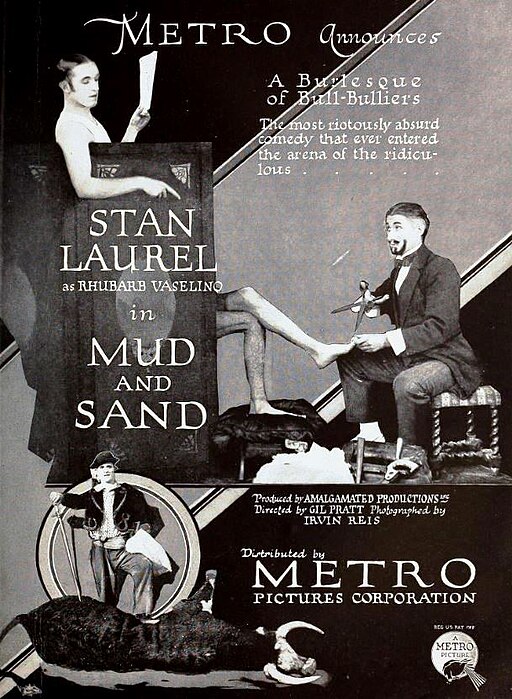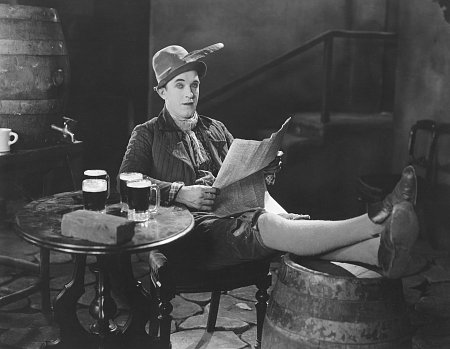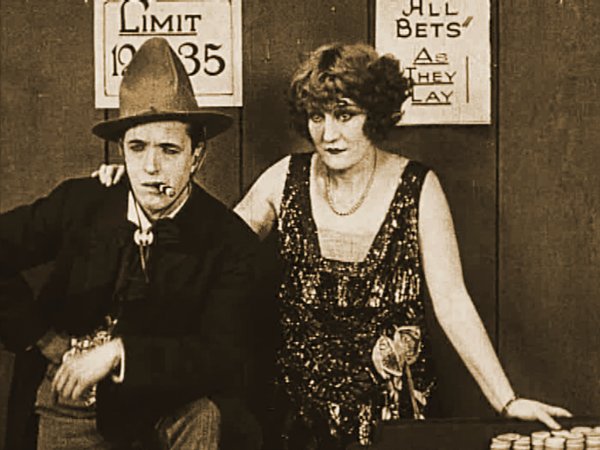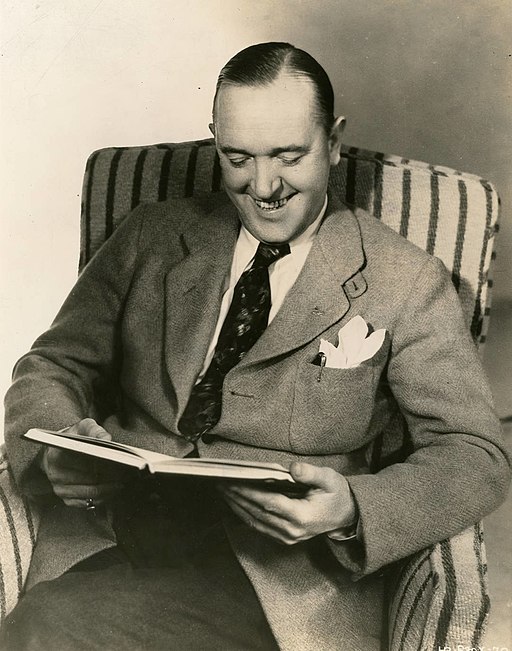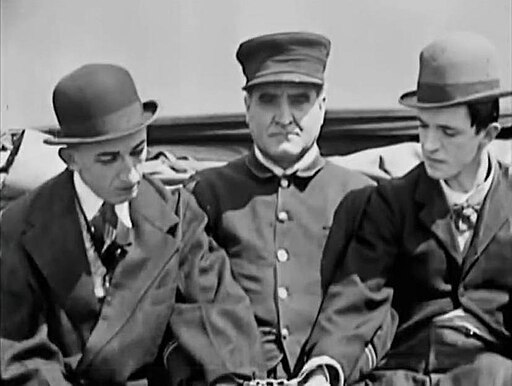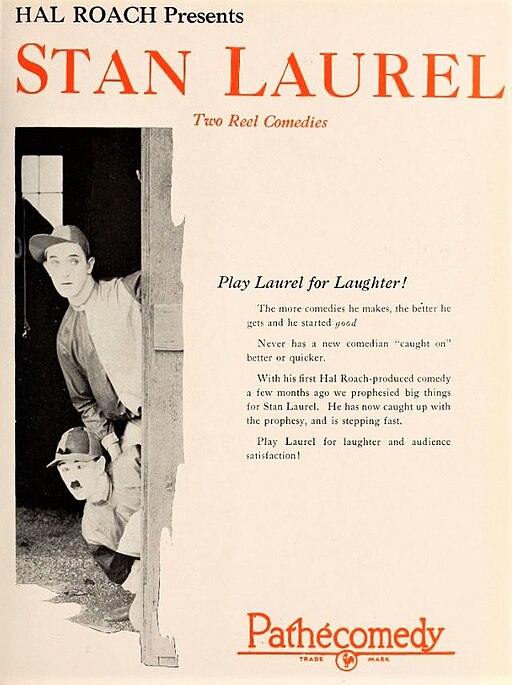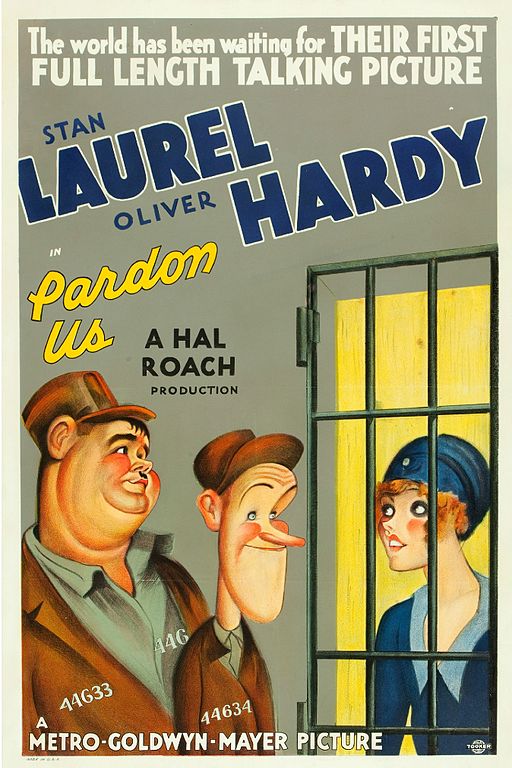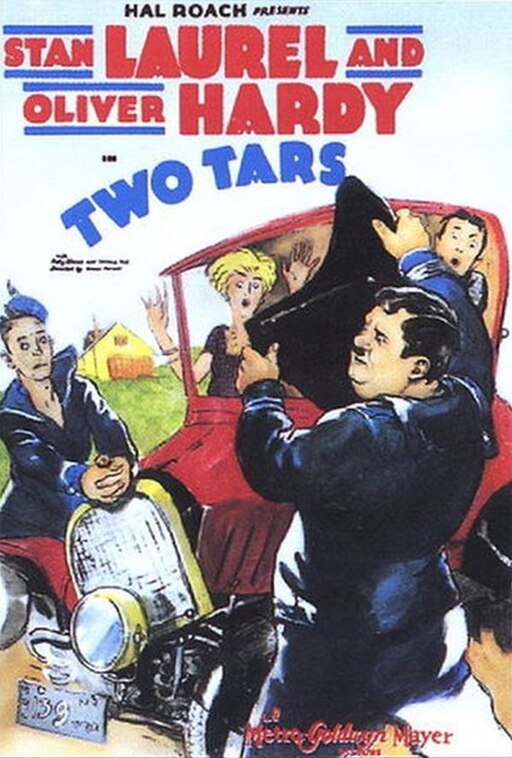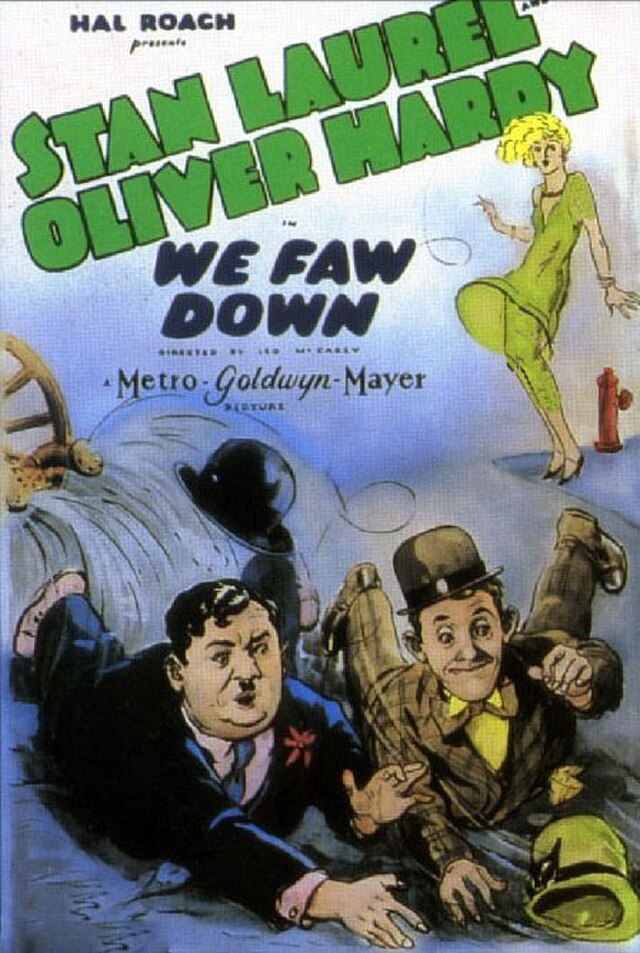Stan Laurel
back| Full Name | Arthur Stanley Jefferson |
| Stage Name | Stan Laurel |
| Born | June 16, 1890 |
| Birthplace | Ulverston, Lancashire, England |
| Died | February 23, 1965 |
| Buried | Forest Lawn Memorial Park, Hollywood Hills, California |
| Married to | Lois Neilson (1926–1934) - Virginia Ruth Rogers (1935–1937 and again 1941–1946) - Vera Ivanova Shuvalova (1938–1940) - Ida Kitaeva Raphael (1946 until his death in 1965) |
| Children | Lois Laurel (daughter) - Stanley Robert Laurel (son, died nine days after birth). Both with Lois Neilson |
| Notable films | Sons of the Desert (1933) - Way Out West (1937) - The Music Box (1932) - Another Fine Mess (1930) - Big Business (1929) - Pardon Us (1931) |
Stan Laurel
The Master of Understated Comedy
Stan Laurel was an English comic actor, writer, and film director who became famous as part of the comedy duo Laurel and Hardy. He began his career in the British music hall, where he developed his skills in comedy and pantomime. In 1910, Laurel went to the United States on a music hall tour and decided to stay, working in American vaudeville and comedy.
Laurel entered the world of silent film in the 1920s and met Oliver Hardy, with whom he would form one of the most famous and enduring comedy partnerships in history. They starred in over 100 films together, transitioning smoothly from silent films to talkies. Their slapstick comedy and memorable characters brought joy to audiences worldwide.
After Oliver Hardy's death in 1957, Laurel was deeply affected and chose not to perform again, turning down the offer to act without his long-time partner. He spent his remaining years responding to fan mail and writing new sketches that he never intended to perform.
Related
Stan Laurel (1890 – 1965)
Biography and Analysis of his Movie Career
Birth and Childhood: Arthur Stanley Jefferson, known to the world as Stan Laurel, was born on June 16, 1890, in Ulverston, Lancashire, England. Growing up in a theatrical family, he was exposed to the stage from a young age. His father was a theater manager and actor, which undoubtedly influenced Laurel's early interest in the performing arts.
Early Career: Laurel honed his skills in the British music hall circuit, a fertile ground for comic talent at the time. He developed a keen sense of timing and a flair for physical comedy, which would later become his trademarks. In 1910, he joined Fred Karno's troupe, where he was an understudy to Charlie Chaplin. This experience was pivotal, as it introduced him to the style of slapstick comedy that would define his career.
Move to America: Laurel's venture to America came with Karno's troupe. He decided to remain in the U.S., working in vaudeville and comedy. It was in the early 1920s when he started his film career in silent movies. His transition from stage to screen was seamless, showcasing his versatile comedic talent.
Laurel and Hardy
Meeting Oliver Hardy: The turning point in Laurel's career came when he met Oliver Hardy. They were initially cast together by chance in silent shorts. Their chemistry was immediate and undeniable. By the late 1920s, they officially became a duo, known as Laurel and Hardy, and began producing a series of successful silent and later sound films.
The Laurel and Hardy Era: Their films were characterized by a unique blend of slapstick and situational comedy. Laurel, the thin, bewildered character, perfectly complemented Hardy, the portly and pompous foil. They became international stars, and their movies are still celebrated for their humor and creativity.
Despite their on-screen chemistry, Laurel and Hardy were quite different in their personal lives. Laurel was more reserved and dedicated to his work, often being the creative force behind their films. He was known for his perfectionism in writing and directing, often contributing more than was credited.
Personal Life
Marriages: Stan Laurel's personal life was marked by its complexity. He was married four times, to three different women. His marriages were often tumultuous, reflecting the challenges of maintaining personal relationships amidst the demands of stardom.
Children: He had two children with his first wife, Lois Neilson. Tragically, their son died nine days after birth, a loss that deeply affected Laurel.
Passions: Apart from his work, Laurel had a passion for writing and was deeply involved in the creative process of his films. He was known for his perfectionism and commitment to the craft of comedy. Despite his screen persona, he was a serious and thoughtful man in his personal life.
Death and Legacy
Later Years: After the death of his partner Oliver Hardy in 1957, Laurel was too heartbroken to perform again. He spent his final years in quiet retirement, though he continued to write comedy sketches and correspond with fans.
Death and Cause: Stan Laurel passed away on February 23, 1965, from a heart attack after battling health issues for several years. He was 74 years old.
Burial and Memorial: He was laid to rest at Forest Lawn Memorial Park in Hollywood Hills, California. His gravestone bears the fitting epitaph, "A master of comedy. His genius in the art of humor brought gladness to the world he loved."
Continued Influence: Laurel's influence on comedy and filmmaking endures. He and Hardy are remembered not only for their contribution to early cinema but also for their ability to connect with audiences through their timeless humor. Stan Laurel's legacy lives on, a testament to his skill, creativity, and enduring appeal as one of the great comic minds of the 20th century.
Interview with Stan Laurel and Oliver Hardy:
Spouses of Stan Laurel:
Stan Laurel, the famous comedian and film actor, was married five times, to four different women. Each of these relationships played a significant role in his personal life. Here's a brief overview of his spouses:
Lois Neilson
- Married: 1926 - 1934
- Background: Lois Neilson, an American actress, met Laurel in the early days of his career. They married in 1926.
- Children: The couple had two children – a daughter named Lois, born in 1927, and a son who died nine days after his birth in 1930.
- Impact: The death of their son was a profound tragedy for the couple. Their marriage eventually ended in divorce in 1934.
Virginia Ruth Rogers
- First Marriage: 1935 - 1937
- Second Marriage: 1941 - 1946
- Background: Virginia Ruth Rogers was married to Laurel twice. Their first marriage ended in divorce, but they remarried a few years later.
- Impact: These marriages were marked by periods of happiness as well as struggles, reflecting the ups and downs of Laurel's life during these years. Their second marriage also ended in divorce.
Vera Ivanova Shuvalova (Illeana)
- Married: 1938 - 1940
- Background: Vera, also known as Illeana, was a Russian singer. Their marriage was tumultuous and attracted considerable media attention at the time.
- Impact: This relationship was particularly rocky, with reports of arguments and legal troubles. They divorced after a brief and troubled marriage.
Ida Kitaeva Raphael
- Married: 1946 until Laurel's death in 1965
- Background: Ida Kitaeva Raphael, originally from Russia, was a widow when she met Laurel. She worked in the music department of 20th Century Fox.
- Impact: Ida was a stabilizing force in Laurel's life. Their marriage was long and, by most accounts, very happy. She supported his career, looked after his health, and remained with him until his death. Ida played a significant role in managing Laurel's legacy after his passing, ensuring his contributions to comedy and film were remembered and celebrated.
Funeral and Grave:
Stan Laurel passed away on February 23, 1965, at the age of 74. His funeral and burial reflected his status as a beloved figure in the world of entertainment and the personal affection many held for him.
Funeral
- Date and Location: The funeral service was held shortly after his death in 1965. It took place in Los Angeles, California.
- Attendance: The funeral was a quiet affair, attended by family, close friends, and some figures from the entertainment industry. Notably, Buster Keaton, a fellow comedy legend and contemporary of Laurel and Hardy, attended the funeral. He was quoted as saying, "Chaplin wasn't the funniest. I wasn't the funniest. This man was the funniest." This statement was a significant tribute to Laurel's impact on comedy.
- Private Ceremony: The service was kept private, respecting the family's wishes and Laurel's own unassuming nature.
Grave
- Location: Stan Laurel was laid to rest at the Forest Lawn Memorial Park in Hollywood Hills, Los Angeles.
- Grave Marker: His grave marker is modest, in line with his personality. It reads, "Stan Laurel, 1890 - 1965," and includes a Masonic symbol, indicating his membership in the Freemasons.
- Epitaph: Interestingly, despite popular belief, the epitaph "If anyone at my funeral has a long face, I'll never speak to him again" is not on his gravestone. This quote was a humorous remark he made but was not used on his actual grave marker.
- Legacy: His resting place has become a site of homage for fans and admirers who visit to pay their respects to the comedy legend.
Notable Movies featuring Stan Laurel:
Silent Era
- "The Lucky Dog" (1921): This film is notable for being the first time Laurel and Hardy appeared on screen together. Laurel plays a down-on-his-luck young man who befriends a stray dog and crosses paths with a robber, played by Hardy.
- "45 Minutes from Hollywood" (1926): An early Hal Roach comedy featuring Laurel before he teamed up officially with Hardy. It's a typical farce of the era, involving mistaken identities and a series of comic mishaps.
Laurel and Hardy Era
- "The Second Hundred Years" (1927): One of the first films to bill Laurel and Hardy as a comedy duo. They play convicts who attempt a daring escape from prison, only to end up back in their cell.
- "Putting Pants on Philip" (1927): Laurel plays Philip, a Scotsman visiting his uncle in America. The film is famous for its scenes where Philip's kilt causes a stir in the conservative American town.
- "Big Business" (1929): A classic silent short where the duo play door-to-door Christmas tree salesmen who get into a tit-for-tat altercation with a homeowner.
Sound Era
- "The Music Box" (1932): This Oscar-winning short film is famous for its scene where Laurel and Hardy struggle to move a piano up a long flight of stairs.
- "Sons of the Desert" (1933): One of their best-known feature films, where they play two husbands who sneak away to attend a lodge convention, leading to a series of comedic misunderstandings.
- "Babes in Toyland" (1934): A musical comedy based on Victor Herbert's operetta, where Laurel and Hardy play two characters who try to save the love interest from a villainous character.
- "Way Out West" (1937): The duo are tasked with delivering the deed to a gold mine to the daughter of a deceased prospector, leading to a series of adventures and misadventures.
- "The Flying Deuces" (1939): Laurel and Hardy join the French Foreign Legion after Hardy's heart is broken. The film is notable for its blend of comedy and pathos.
Later Years
- "A Chump at Oxford" (1940): The duo earn a scholarship to Oxford University after stopping a bank robbery, but things don't go as planned in this classic comedy.
- "The Bullfighters" (1945): One of their later films, in which Hardy is mistaken for a famous bullfighter, leading to a series of comedic events in the bullring.
Laurel and Hardy Video: Playing Pool:
Analysis of the Acting Style of Stan Laurel:
Stan Laurel's acting style, particularly evident in his work with Oliver Hardy, is a masterclass in the art of classic comedy. His approach to humor was multifaceted, blending elements of slapstick, pantomime, and a unique subtlety that set him apart from his contemporaries. Let's delve into the various aspects of his style:
Physical Comedy and Slapstick
- Mastery of Slapstick: Laurel was a master of slapstick, a form of comedy characterized by physical humor and exaggerated, often clumsy actions. His ability to turn a simple task into a comedy of errors was unparalleled. This was evident in scenes where routine activities, like putting up a picture frame or painting a door, resulted in chaotic and hilarious outcomes.
- Expressive Body Language: Laurel's body language was remarkably expressive. He could convey a wide range of emotions through his physicality alone – from his wide-eyed look of bewilderment to his signature scratch of the head when puzzled. This non-verbal communication was a key element of his comedic arsenal.
Facial Expressions
- Rubber-faced Expressions: Often referred to as "rubber-faced," Laurel had the ability to contort his face in ways that enhanced the comedic effect of his performance. His surprised look, with eyes wide and mouth agape, or his crestfallen expression with a quivering chin, added a layer of humor that transcended the need for dialogue.
- Emotion-Conveying Glances: Laurel's skill in using facial expressions extended to the subtle art of conveying emotions through simple glances. Whether it was a look of innocence, confusion, or slyness, his face was a canvas that depicted a range of feelings, often complementing the broader slapstick elements of his performances.
Timing and Rhythm
- Impeccable Timing: Timing is crucial in comedy, and Laurel had an innate sense for it. His ability to deliver lines, react to situations, or engage in physical comedy at just the right moment made his performances rhythmically captivating.
- Pacing and Pauses: Laurel understood the power of pacing and pauses. He knew when to speed up the action for comic effect and when to slow it down, allowing the audience to anticipate and savor the humor. His strategic use of pauses, especially in dialogue with Hardy, created a comedic tension that often resulted in big laughs.
Chemistry with Oliver Hardy
- Complementary Dynamics: The contrast between Laurel and Hardy was a cornerstone of their success. Laurel's childlike naivety played off perfectly against Hardy's more pompous, self-important character. This dynamic created a relatable and endearing partnership that resonated with audiences.
- Subtle Interplay: Beyond the overt comedic moments, Laurel's interactions with Hardy were filled with subtle, often non-verbal exchanges that added depth to their performances. A slight nod, a perplexed look, or a resigned sigh in response to Hardy's antics all contributed to the richness of their on-screen relationship.
Emotional Range
- Beyond Comedy: While primarily known for his comedic talents, Laurel also demonstrated a capacity to convey genuine emotion. He could evoke sympathy, often playing the underdog or the innocent caught in a bewildering world. This emotional range added a layer of depth to his character, making him more than just a comic figure.
Innovation and Adaptability
- Evolution with the Medium: Laurel's style evolved with the changing landscape of cinema. He transitioned seamlessly from silent films, where physical comedy and expressions were paramount, to talkies, where verbal humor and sound effects became integral parts of his performances.
Conclusion
Stan Laurel's acting style was a blend of physical humor, expressive facial gestures, impeccable comedic timing, and a deep understanding of character dynamics, particularly in relation to Oliver Hardy. His work remains a benchmark in the world of comedy, embodying a timeless quality that continues to delight audiences of all ages. His influence can be seen in the works of countless comedians and actors who followed, a testament to his enduring legacy in the art of comedic performance.
Memorable Quotes from Stan Laurel:
- "If anyone at my funeral has a long face, I'll never speak to him again." - This humorous remark reflects Laurel's lifelong dedication to making others laugh, even in reference to his own mortality.
- "I don't deserve to be mentioned in the same sentence with Charles Chaplin." - Laurel was known for his humility and respect for his fellow comedians.
- "A comedian can only last till he either takes himself serious or his audience takes him serious." - This quote reflects his understanding of the delicate balance required in comedy between the performer and the audience's perception.
- "All I know is what I read in the papers." - Often used in their films, this line showcased Laurel's portrayal of a character who was charmingly out of touch with reality.
- "Humor is the truth; wit is an exaggeration of the truth." - Stan Laurel's views on comedy often revealed his deeper understanding of the mechanics and philosophy behind making people laugh.
- "Life isn’t short enough." - A wry comment on life's trials and tribulations, this quote reflects Laurel's ability to find humor in the human condition.
Awards and Recognition:
Stan Laurel, renowned for his work in the comedy duo Laurel and Hardy, did not receive a large number of awards during his lifetime, partly due to the era in which he worked. However, his contributions to film and comedy were recognized, especially later in his career and posthumously. Here's an overview of the notable awards and recognitions he received:
Lifetime Achievements and Honors
- Academy Award: Laurel was awarded an Honorary Oscar in 1961 "for his creative pioneering in the field of cinema comedy." This award was a significant recognition of his contributions to the film industry and his influence on the genre of comedy.
- Stars on the Hollywood Walk of Fame: Both Stan Laurel and Oliver Hardy have stars on the Hollywood Walk of Fame, commemorating their work in motion pictures. Laurel's star is located at 7021 Hollywood Blvd.
Posthumous Recognitions
- Laurel and Hardy films have been consistently praised and studied for their comedic genius and have been preserved by various film institutes for their cultural, historical, and aesthetic significance.
- Various film festivals and retrospectives have been dedicated to Laurel and Hardy, showcasing their work and influence on the film industry.
Other Honors
- Statues and Memorials: In his birthplace of Ulverston, England, there is a statue of Laurel, and in Bishop Auckland, there is a plaque at his childhood home. These memorials serve as a testament to his lasting impact and the affection with which he is still held.
- Laurel and Hardy Museum: In Ulverston, there is a museum dedicated to Laurel and Hardy, celebrating their work and legacy.
Comprehensive List of Movies with Stan Laurel:
Solo Career (Before Teaming with Oliver Hardy)
- Nuts in May (1917)
- Bears and Bad Men (1918)
- Do You Love Your Wife? (1919)
- Hustling for Health (1919)
- Just Rambling Along (1918)
- The Egg (1922)
- The Weak-End Party (1922)
- The Pest (1922)
- When Knights Were Cold (1923)
- Frozen Hearts (1923)
- The Whole Truth (1923)
- The Noon Whistle (1923)
- Pick and Shovel (1923)
- White Wings (1923)
- Under Two Jags (1923)
- Short Orders (1923)
- A Man About Town (1923)
- The Garage (1920)
- The Bakery (1921)
- The Rent Collector (1921)
- The Lucky Dog (1921)
- Kill or Cure (1923)
- Gas and Air (1923)
- Collars and Cuffs (1923)
- Save the Ship (1923)
- Scorching Sands (1923)
- Oranges and Lemons (1923)
- The Soilers (1923)
- Mother's Joy (1923)
- Near Dublin (1924)
- Rupert of Hee Haw (1924)
- Smithy (1924)
- Detained (1924)
- Brothers Under the Chin (1924)
- Wide Open Spaces (1924)
- Monsieur Don't Care (1924)
- West of Hot Dog (1924)
- Zeb vs. Paprika (1924)
- The Snow Hawk (1925)
- Navy Blue Days (1925)
- Dr. Pyckle and Mr. Pryde (1925)
- Half a Man (1925)
- Twins (1917)
- The Serenade (1916)
- The Hero (1917)
- The Hobo (1917)
- The Suspect (1916)
- The Candy Kid (1917)
- The Boycotted Baby (1917)
- The Villain (1917)
- The Goat (1918)
- The King (1918)
- The Slave (1917)
- The Chief Cook (1917)
- The Pest (1917)
- The Candy Trail (1918)
- The Midnight Cabaret (1918)
- The Tip (1918)
- The Dummy (1917)
- The Escape (1917)
- The Girl from Everywhere (1927)
- The Fight Pest (1937)
Laurel and Hardy Films
- 45 Minutes from Hollywood (1926)
- Duck Soup (1927)
- Slipping Wives (1927)
- Love 'Em and Weep (1927)
- Why Girls Love Sailors (1927)
- With Love and Hisses (1927)
- Sugar Daddies (1927)
- Sailors, Beware! (1927)
- The Second Hundred Years (1927)
- Now I'll Tell One (1927)
- Call of the Cuckoo (1927)
- Hats Off (1927)
- Do Detectives Think? (1927)
- Putting Pants on Philip (1927)
- The Battle of the Century (1927)
- Leave 'Em Laughing (1928)
- Flying Elephants (1928)
- The Finishing Touch (1928)
- From Soup to Nuts (1928)
- You're Darn Tootin' (1928)
- Their Purple Moment (1928)
- Should Married Men Go Home? (1928)
- Early to Bed (1928)
- Two Tars (1928)
- Habeas Corpus (1928)
- We Faw Down (1928)
- Liberty (1929)
- Wrong Again (1929)
- That's My Wife (1929)
- Big Business (1929)
- Unaccustomed As We Are (1929)
- Double Whoopee (1929)
- Berth Marks (1929)
- Men O'War (1929)
- Perfect Day (1929)
- They Go Boom (1929)
- Bacon Grabbers (1929)
- The Hoose-Gow (1929)
- Hollywood Revue of 1929 (1929)
- Angora Love (1929)
- Night Owls (1930)
- Blotto (1930)
- Brats (1930)
- Below Zero (1930)
- Hog Wild (1930)
- The Laurel-Hardy Murder Case (1930)
- Another Fine Mess (1930)
- Be Big! (1931)
- Chickens Come Home (1931)
- Laughing Gravy (1931)
- Our Wife (1931)
- Pardon Us (1931)
- Come Clean (1931)
- One Good Turn (1931)
- Beau Hunks (1931)
- On the Loose (1931)
- Helpmates (1932)
- Any Old Port! (1932)
- The Music Box (1932)
- The Chimp (1932)
- County Hospital (1932)
- Scram! (1932)
- Pack Up Your Troubles (1932)
- Their First Mistake (1932)
- Towed in a Hole (1932)
- Twice Two (1933)
- Me and My Pal (1933)
- The Midnight Patrol (1933)
- Busy Bodies (1933)
- Dirty Work (1933)
- Sons of the Desert (1933)
- Oliver the Eighth (1934)
- Going Bye-Bye! (1934)
- Them Thar Hills (1934)
- The Live Ghost (1934)
- Tit for Tat (1935)
- The Fixer Uppers (1935)
- Thicker than Water (1935)
- Bonnie Scotland (1935)
- The Bohemian Girl (1936)
- Our Relations (1936)
- Way Out West (1937)
- Swiss Miss (1938)
- Block-Heads (1938)
- The Flying Deuces (1939)
- A Chump at Oxford (1940)
- Saps at Sea (1940)
- Great Guns (1941)
- A-Haunting We Will Go (1942)
- Jitterbugs (1943)
- The Dancing Masters (1943)
- The Big Noise (1944)
- Nothing But Trouble (1944)
- The Bullfighters (1945)
- Atoll K (1951)

